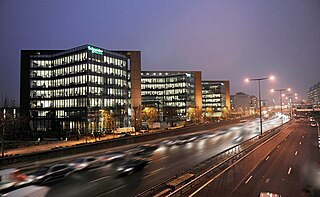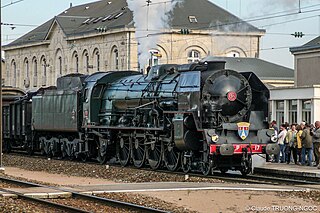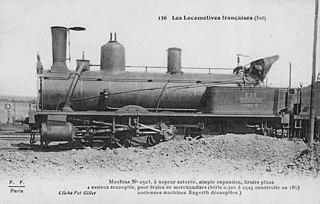
Heavy equipment, heavy machinery, earthmovers, construction vehicles, or construction equipment, refers to heavy-duty vehicles specially designed to execute construction tasks, most frequently involving earthwork operations or other large construction tasks. Heavy equipment usually comprises five equipment systems: the implement, traction, structure, power train, and control/information.

Schneider Electric SE is a French multinational corporation that specializes in digital automation and energy management.

The SNCF 241.P is a 4-8-2 'Mountain' type express passenger steam locomotive that ran on the Société Nationale des Chemins de fer Français, from 1948 until 1973. Introduced as large scale electrification of the SNCF was already underway, they were the last new class of passenger steam locomotives in France.

État 140-101 to 140-370 is a class of 2-8-0 steam locomotive of the Chemins de fer de l'État, and subsequently the Société Nationale des Chemins de fer Français (SNCF).

The Chemin de Fer de la Baie de Somme, is a preserved railway in northern France. The railway is managed by a non-profit organization, which runs from March to December between the towns of the Baie de Somme area: Le Crotoy and Cayeux-sur-Mer via Noyelles-sur-Mer and Saint-Valery-sur-Somme, on metre gauge tracks. The association was founded in 1970 and over the years it has become a major player in tourism development in the Picardy coast and is also responsible for the preservation, safeguarding and enhancement of the fleet full of cars, wagons, steam locomotives and diesel locomotives. A part of the line has dual gauge track, and although forming part of a group of five lines, at least a part of it has always been open to traffic.

Corpet-Louvet was a steam locomotive manufacturer based in Paris, France.

The Chemins de fer du Morbihan (CM) was a metre gauge railway in Morbihan, France, with some track in Loire-Inférieure. The first lines opened in 1902 and the system had a total extent of 433 kilometres (269 mi).
The Société Franco-Belge was a Franco-Belgian engineering firm that specialised in the construction of railway vehicles and their components and accessories. The company originated in 1859 as the Belgian firm Compagnie Belge pour la Construction de Machines et de Matériels de Chemins de Fer, founded by Charles Evrard. The company expanded its share capital in 1881 forming a new firm Société Anonyme Franco-Belge pour la Construction de Machines et de Matériel de Chemins de Fer and constructed a factory in Raismes (Valenciennes) in the Département Nord in France.
Tadano Ltd. is the main and largest Japan-based manufacturer of cranes and aerial work platforms, considered one of largest crane manufacturers in the world.

Link-Belt Cranes is an American industrial company that develops and manufactures heavy construction equipment, specializing in telescopic and lattice boom cranes. Link-Belt is headquartered in Lexington, Kentucky, and is a subsidiary of the Japanese conglomerate, Sumitomo Heavy Industries.
The Heilmann locomotives were a series of three experimental steam–electric locomotives produced in the 1890s for the French Chemins de fer de l'Ouest. A prototype was built in 1894 and two larger locomotives were built in 1897. These locomotives used electric transmission, much like later-popular diesel–electric locomotives and various other self-powered locomotives.

The SNCF BB 1280 class were a class of 600 V DC 4 axle Bo′Bo′ electric locomotives, formerly Compagnie du chemin de fer de Paris à Orléans machines, initially built for an underground section of line connecting the Gare d'Austerlitz to the Quai d'Orsay in inner Paris. The locomotives were converted for 1500 V DC use in the 1930s, and renumbered PO E.281 to E.293. They were absorbed by the SNCF, and operated as shunters until the late 1960s.
The Compagnie des forges et aciéries de la marine et d'Homécourt was a French industrial enterprise that made iron and steel products for the French navy, army, and railroads. It is often known as Saint-Chamond from its main location in Saint-Chamond, Loire.

SNCF 232.P.1 was an experimental prototype high-pressure steam locomotive ordered by the Chemins de fer du Nord, but delivered to the Société nationale des chemins de fer français (SNCF) in 1939. It was the first and only member of SNCF's first class of 4-6-4 or Hudson type of locomotives.
The SNCF 232.Q.1 was an experimental prototype steam locomotive of the Société nationale des chemins de fer français (SNCF) which entered service in 1940. It was Baltic or 4-6-4 locomotive.

The Est 0.501 to 0.691, also denoted as Est 0501 to 0691, was a class of 191 French 0-8-0 locomotives for freight service, built from 1856 to 1886 for the Chemins de fer de l'Est.

The Belgian State Railways Type 1 was a class of 2-4-0 steam locomotives for passenger service, introduced in 1864.

The Compagnie des chemins de fer algériens de l'État (CFAE) was a French company established in 1908 in Algeria to operate a network of narrow-gauge railway lines in the regions of Constantine, Oran, and Bône.
LBX is an American industrial company manufacturing excavators, forestry equipment and scrap material handlers.














